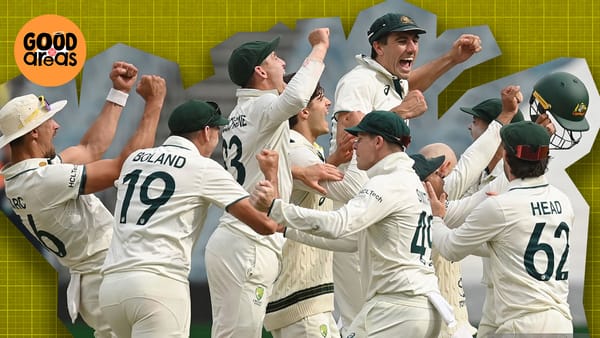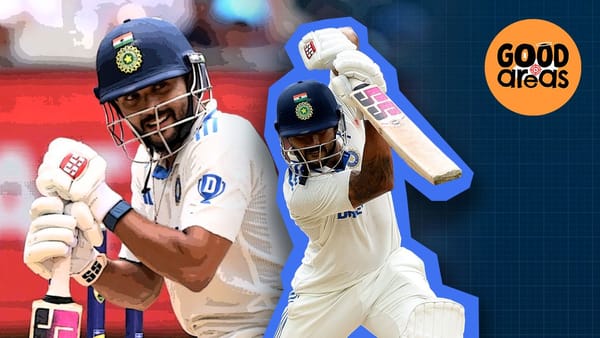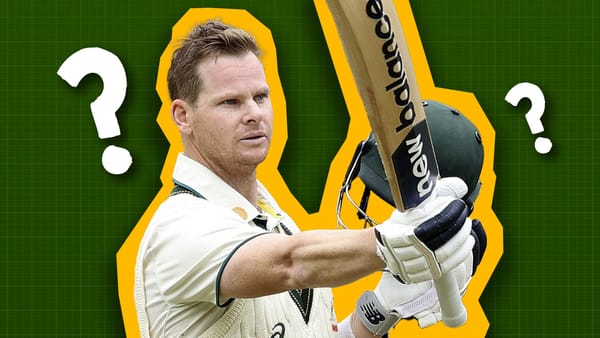Professional Women
In the 1800s there was a professional league for women, it took them over 100 years to be paid again.
This is the transcript of Episode 5, Season 1, of Double Century.
SE1EP5 - professional women
— Jarrod Kimber (@ajarrodkimber) 8:35 PM ∙ Nov 20, 2020
The story of how the women's game struggle to go pro.
Crowds of 15000 to 20000 turned up to watch the blue and red women play.
They were part of The Original English lady cricketers. That was in 1890, a mere 120 years after proving the women's game could be financially sound, women International players got their first professional contracts.

Welcome to Double Century. This week we look at the long road the women's game took to professionalism. This involves paying for your own blazer, not being able to play if you were married, playing with a broken leg and then ending up in Brazil. For the longest time, to play cricket at the highest level, you needed to be from a commonwealth country or have a penis. That is now changing.
That cricket league I talked about at the top was one where women were recruited through a newspaper ad by a French- American entrepreneur, MR E Michael. His ad read that he was looking for women, "of good address and appearance, respectable, strong, active, not under 5ft. 6in. in height or over twenty-two years of age." They played sixty games, most seen by 2000 spectators, and that one in Liverpool where 15000 to 20000 attended. It wasn't well reported on, and you'd argue the quality would have been poor being that cricket skills were not that important in the ad. WG Grace said at the time "cricket is not a game for women and although they occasionally join in a picnic game they are not constitutionally adapted for the sport". Who would have thought Grace would be on the wrong side of history here.

The games lost interest after a while, probably because the cricket was so poor once the novelty dropped. And also bizarre things like the women didn't play under their own names. The founder eventually fled with all the money, and women's cricket struggled for any attention, even hateful or perverted, for a long time after.
There wasn't even a Women's Test match played until 1934/35. That is when an English team toured Australia. The English women were all single; married women simply could not be away from their families. These single women had to pay for £80 per head for the honour of representing their country. They were also told not to smoke, drink or gamble or "be accompanied by a man". Many men's tours should have had the same advice.
Betty Archdale was their captain, a daughter of a famous suffragette, and a strong batter. She led from the front in the low scoring series that England won 2-0. England also beat New Zealand in their first Test of that period. In the follow-up series Australia one the first Test, England the second and into the third England's keeper the great - in name and playing - Betty Snowball made 99 in a draw.
On the topic of great names, one of the great early players was Myrtle Maclagan. She was an incredible cricketer, averaging over 40 with the bat, and under 16 with the ball. She opened the batting and bowling, she probably could have kept it she wanted too. Women's cricket remained incredibly amateur, and almost entirely the domain of England, Australia and New Zealand for a long time.
Then a heroine arrived. She hit the first six in a Women's Test. She batted for 521 minutes in making a world record 179 against Australia at The Oval to draw a Test. She averaged 45 in Tests. Made three hundreds. When she retired, she made 33% more runs than any other woman in history. She was the cricketer of her time. Of all time. But as great as she was a player, Rachael Heyhoe-Flint changed cricket more off the field. The first World Cup started after a conversation with her over a bottle of brandy.
In 1973, two years before the men, the women played the first World Cup. The teams were Australia, New Zealand, Jamaica, Trinidad and Tobago, England, Young England and an International XI. And she also was responsible for the first women's match at Lord's. Women's cricket has had great players, and even of recent times, some great teams, but it has always lacked depth. At this stage, it lacked teams and coverage.
Heyhoe-Flint and the other players went around town, putting up banners to promote it. She also tried to ring up as much media attention as she could. It was tough. The first game was between New Zealand and Jamaica. It rained, and no one turned up to watch it. She was more than just a cricketer. This is from her Guardian Obituary, "Jarrod Kimber called her "the WG Grace of women's cricket" and he was being only slightly hyperbolic." I wasn't being hyperbolic at all. Grace came into an existing industry and was the first global sporting star, Heyhoe Flint created the industry herself.
She brought the women's game to the world, forced them to talk about, went out on street corners taking donations, found some of the first sponsors for the game. And she wrote about it as a journalist, often writing match reports of games she was in just to make sure someone covered them. WG Grace wasn't out on street corners grabbing people's spare change or writing up a solid 150 words on matches he played in. And she did it at a time when she wasn't allowed to be an MCC member because she was a woman, but she was holding cricket's first World Cup. That's a statement.
She captained the first Women's team at Lord's, was in the first group of Women MCC members, a life member of the MCC, on the board of Wolverhampton Wanderers and one of the first-ever women sport's commentators. The first woman inducted into the ICC's Hall of Fame and one of the two first women appointed to the board of the ECB. She became a House of Lord's peer, a baroness. MCC should be ashamed that, while they have elected rebel players to be president, they never found a place for one of the club's shining lights.
When she passed away, it was during the Women's Big Bash League. As women's cricketers are being paid as professionals in a domestic competition with players from New Zealand, South Africa, India, England and West Indies in Australia that has been broadcast on TV. When Heyhoe Flint was a child, she wouldn't have dreamed of such a thing. Now young girls can grow up and dream of playing cricket for a living.
The power of women's cricket moved towards Australia for a while, and much of that was because of one incredible player, "…Belinda Clark medal goes to..."
Belinda Clark made the first international double hundred in an ODI, she averaged 37 in ODIs, 47 in Tests and captained two World Cup wins. The Belinda Clark medal is part of Australia's award ceremony for cricketers.
She has worked as an administrator for the women's game, and the men's. She has also commentated on cricket, and along with English legend Clare Connor, they rewrote the rules of the Women's Ashes. But the critical thing about Clark was that she wasn't on her own. In 1994 at the SCG there was an exhibition match, Bradman XI v World XI all-stars. Zoe Goss, the Australian all rounder was bowling and Brian Lara was batting.
That wicket pushed the women's game massively. But other than Goss there was Cathryn Fitzpatrick - known as the fastest women's bowler in the world and Karen Rolton, who was probably, possibly, an even better batter than Clark. But while most Australian cricket fans probably knew one of these players, and they played in a World Cup final at Eden Gardens in front of 80,000 fans, the players had to pay to play.
Goss once said, "I probably spent a good down-payment on a mortgage while I was playing, if you added up the player levies that we had to pay for state and international cricket."
If that sounds horrible, it is, considering that by 1997 Cricket Australia were making a fair whack of money. The ECB were charging their players as well. But these women were desperate to play cricket. Not because it would make them rich, it actively made them poorer. But because they loved it. The running joke in pro cricket is you play your first 20 Tests for love and the rest for money.
Not one of these women played more than 20 Tests. And even if they had, there would still be no money. They played because of the game.
The 2013 World Cup final was Australia up against the West Indies. The fact that they named the tournament and earlier England had been beaten by Sri Lanka showed that finally, the women's game was moving beyond the three main sides. Ellyse Perry who once kicked the goal of the tournament in a women's football World Cup was bowling for Australia.
In Australian cricket, the ghost of Rick McCosker's jaw is never far away.
McCosker was in hospital for a day and a half after his jaw was broken on the first morning of the centenary Test after hooking a bit early against Bob Willis. But with a broken jaw, in two places, McCosker still came back in to bat and help Australia win. His face was surrounded by a bandage, his head as protected with the baggy green. John Lever bounced him. McCosker hooked for four. He made 25 in a partnership of 50. Australia won the Test by 45 runs.
Perry shouldn't have played in the final. Australia had a potential replacement in Holly Ferling, who'd done so well that Perry needn't have been tested. But she is a star, and she wanted to help win the World Cup for her team. Australia took a gamble on her fitness. With the bat, Perry's foot held up. She slogged her way to 25 off 22, the only Australian batter with a strike rate above 100, and woke up an innings that was dipping into a coma.
When she came on to bowl, West Indies had handled the new ball well. They'd built a platform, not lost a wicket, and still had Stafanie Taylor and Deandra Dottin to come, the West Indies star hitters. Australia needed Perry.
Instead of steaming in and firing through the openers, Perry barely got to the crease for her first attempt. She pulled up, limped and looked worried. As did every other Australian player. It didn't look like she'd get through a ball, let alone an over. The second attempt was much the same. It ended in no delivery, pain and worry.
It was then that the captain Jodie Fields shot a look off to the dressing room. It wasn't a happy look. Australia's gamble was about to cost them ten overs of a strike bowler, and Fields was suddenly trying to work out how she was going to make up for that. Perry could have limped off.
But she refused to give up. Her third attempt was painful to watch, it was someone hurting, someone who didn't trust her body, but somehow she delivered a ball. Nothing great, but one more than looked likely. Her teammates screamed their support. The ball was left alone and went through to Fields, who kept the ball and ran up to Perry. It was the briefest of chats, perhaps just mindless support. Fields knew how important every ball Perry bowled was. It was the difference between the West Indies having a chance to win, and not. Whatever was said got Perry through the over.
With her sixth ball, Perry took Kycia Knight with a dodgy LBW. Perry's seventh took the edge of West Indies' gun, Taylor, but the evidence on the catch at slip was inconclusive. Perry's tenth ball, she had Taylor out caught and bowled. Perry's 15th was Natasha McLean's wicket. After three overs Perry had 3-2-2-3.
Perry might have limped her way through it, but it was West Indies who never recovered. She could have stepped back from there.
She wouldn't allow herself to become a passenger. Perry kept giving it her all. She raced around for run-outs, dived to stop singles, threw herself threw into the air unsafely, unwisely and ungainly to catch Deandra Dottin. And continued to bowl.
Perry bowled her entire ten overs, often limping in between balls or overs, but she just kept going until Australia had won the World Cup. In her last over, Perry bowled a bouncer. It was a special effort, courageous and skilful.
An injured foot is not quite as sexy as McCosker's broken jaw. Still, ten days after the final the x rays showed that Perry had a broken foot, a stress fracture in her distal left tibia. She had won a World Cup on a broken leg.
A year later the England women were told they would be made professional. Charlotte Edwards, one of the greatest players ever said on Twitter, "Today is a day I never thought I'd see in my time as a player!" In the years since many nations have made steps around the world to make their women professional. Australia has 100 professional women, Sri Lanka used their armed forces cricket teams to train their women, and the women's game has grown massively in recent years. In 2020, 86,174 came to see the final of the World Cup at the MCG.
These women were not selected because they were under 22 and tall, they did not pay for their blazers, and many were paid to play. If you have followed women's cricket even casually, you knew what this meant.
So many men say to me, "the women's game is crap, they aren't fit, they don't bowl fast, and there aren't enough good players". I always say the same thing, the men had a 20-year professional head start.
It was that World Cup that Thailand qualified, an incredible achievement for them, and a huge step for cricket. For too long women and non-commonwealth countries didn't exist in cricket, the ICC shunned the women's game for almost a 100 years. And to add to that, in January this year, a really small thing happened that was barely reported but was magical. The Associação Brasileira de Cricket – Brazil's cricket board – gave out 14 contracts for their women's team. They become the First Nation to fully professionalise their women's team, ahead of their men. Do you know why they did it, because they could only afford to make one team professional, and the women were doing better.
At my first cricket club women made the tea. Now they make hundreds.
Double Century is written and narrated by me, Jarrod Kimber. It’s produced by Nick McCorriston. And my fact-checkers were Bertie Moores and Abhishek Mukherjee.
This episode was made possible by our supporters on Patreon.
The latest Red Inker Podcast is with Andrew Fidel Fernando on Murali. It’s really interesting.
🎙🎙Red Inker out now 🎙🎙
— Jarrod Kimber (@ajarrodkimber) 10:17 AM ∙ Dec 2, 2020
It’s only bloody @afidelf popping in to talk about Murali. Stuff this in your ears.
podcasts.apple.com/gb/podcast/red…




